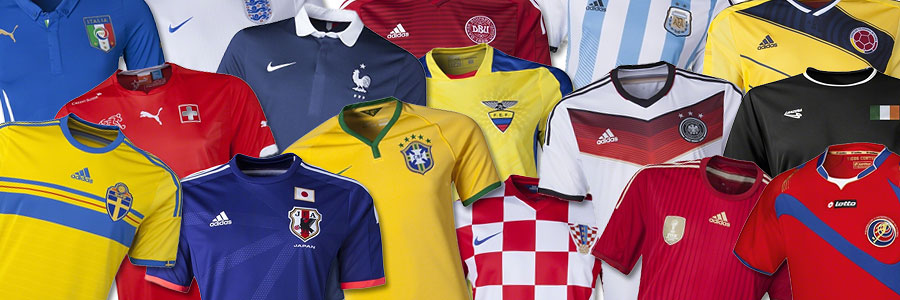Colouring Games
Winning isn’t everything, they say. That’s true. Equally important is how you look.
At least that’s the impression one gets whenever clubs unveil their new kits for the coming season or national teams present their shirts and shorts for an upcoming tournament. It never fails to elicit howls of protest from fans who always complain about one thing or another, be it the colours or the cut or the collars.
But seldom were the complaints as loud as in March, when a number of countries introduced the kits they will be wearing at the World Cup in Brazil this summer. That’s because many teams, among them tournament favourites or co-favourites like Argentina, England, Germany, Portugal or Spain, dropped their traditional look and switched to one-colour kits.
Germany in all-red? Spain dressed neck-to-toe in blue? England in white shirts and white shorts? People don’t like drastic changes, so you can understand why there was very strong criticism. However, what many people didn’t realise was that the teams’ various kit manufacturers were simply following FIFA orders.
Last October, FIFA published their set of regulations for the 2014 World Cup. It came in two parts. One for the “preliminary competition”, meaning the remaining matches of the qualifying rounds, and one for the “final competition”, meaning the games in Brazil.
The rules regarding equipment for the qualifiers read: “Each team shall have an official and reserve team kit, which shall be declared on the team colour form. The colours of the reserve team kit (shirt, shorts and socks) shall be noticeably different from and contrast with the colours of the official team kit (shirt, shorts and socks).”
But the rules regarding equipment for the games in Brazil were phrased differently. They read: “Each team shall inform FIFA of two different and contrasting colours (one predominately dark and one predominately light kit) for its official and reserve team kit (shirt, shorts and socks).”
It’s unclear why the rule change was made. The “Guardian” newspaper argued that a one-colour look is meant “to aid referees”, whereas the “Daily Mirror” said that teams were asked “to adopt predominantly singled-coloured kits to improve the quality of HD television pictures”. In any case, what happened was that kit suppliers interpreted the words “predominately dark” and “predominately light” as meaning “single-coloured”.
It may seem like a break with tradition to be told what to wear by a governing body, but in fact it’s how some of the most classic kits in club football came about. In September 1890, Sunderland AFC (who were newly elected to England’s Football League) played against Wolverhampton Wanderers. Both teams wore black socks, black shorts and shirts with red and white stripes. The referee was as confused as the crowd.
This led to a rule change at the Football League’s next annual meeting. For the 1891-92 season, clubs had to register their colours with the League, which would make sure that no two clubs wore the same colours. Wolves were now forced to find colours nobody else used. Initially, they settled on orange and blue. When the rule was made less restrictive one year later, the club chose gold and black, the colours they wear to this day.
Now, you might think, 1890 – that was a long time ago. These things surely no longer happen. Well, you’d be surprised how often similar kits have caused a problem even on the biggest stage of all, the World Cup.
In 1934, both Austria and Germany took the field for the third-place match in Naples wearing white shirts and black shorts – and neither team carried a reserve kit. The only substitute shirts that were quickly available were Napoli shirts and so Austria played the game in an unfamiliar pale blue.
Twenty-four years later, a similar problem arose in an even bigger game. Only two teams at the 1958 World Cup wore the unusual combination of yellow shirts and blue shorts: hosts Sweden and Brazil. Of course both then reached the final. A few days before the game, a coin was tossed to see who could wear his normal colours. Sweden won. However, Brazil didn’t have a second kit. So FIFA officials hastily bought blue shirts and white shorts in Stockholm. Brazil removed the badges from their yellow shirts and sewed them onto the blue ones. They won the final – and have used blue-and-white as their away colours ever since.
The final wasn’t even the first case of a team having to change into an unfamiliar kit at this World Cup. On the very first day, June 8, Argentina played against West Germany. Referee Reg Leafe complained that the two kits were too similar and Argentina were forced to play the game in the yellow shirts of a Swedish team. (Not Malmö FF, as is sometimes reported, but IFK Malmö.)
It wasn’t the last time in World Cup history that a national team had to play in the colours of a local club instead of their own. On June 10, 1978, France met Hungary in their final group match at the World Cup in Argentina. Hungary were supposed to play in all-white, France in all-blue. However, when the French arrived at the ground in Mar del Plata, they had white shirts and white shorts with them – and no substitute kit.
The referee asked the Hungarian national team to either change into their reserve kit (all red) or allow the French to wear it, but Hungary refused. And so somebody from the French delegation had to find a kit for his players to wear. Luckily, there was a local team, Club Atlético Kimberley, that agreed to help the desperate French. When the game finally kicked off, 40 minutes later than planned, France wore red socks, blue shorts and green-and-white-striped shirts.
Maybe you can now understand why FIFA drew up rules to make sure something like this will never happen at a World Cup again.
© IFFHS 2014
